METHOD FOR ESTIMATING THE LENGTH OF FATIGUE CRACKS DURING THEIR HEALING BY PULSED ELECTRIC CURRENT
10.25712/ASTU.1811-1416.2024.03.003
Keywords:
fatigue tests, fatigue crack, crack length, finite element methodAbstract
Recently, intensive research has been conducted on fatigue crack healing by passing pulses of high-density electric current. In this case there is a problem of determining how much the crack has shortened due to melting of the material at the crack tip caused by Joule heating. The difficulty in solving this problem is that after partial welding of the crack it is not easy to determine the location of the crack tip using an optical microscope. Determining the exact location of the crack tip is also difficult for specimens with contaminated or corroded surfaces. In this paper, we propose an approach to estimating the crack length in fatigue-loaded specimens based on the solution of a two-dimensional elasticity theory problem. The problem of determining the crack opening when cantilevered specimens are loaded with a bending load in the elastic region is solved by the finite element method. The maximum Mises stresses in the specimen when loaded with a unit bending force were calculated. The crack opening value can be measured using an optical measuring microscope and the crack length can be determined from the calculation results. To test the proposed approach, experimental studies were carried out on strips of VT6 titanium alloy with mirror polished surface, which allowed measuring the length of fatigue crack using an optical microscope. Three specimens with cracks of different lengths were obtained, for which bending tests were carried out with measurement of the crack opening value using an optical microscope. In addition, the crack length was determined from a finite element calculation relating the crack length to the crack opening at a given load. The experimental results are in good agreement with the modeling results.











 Journal «Fundamental’nye problemy sovremennogo materialovedenia / Basic Problems of Material Science»
Journal «Fundamental’nye problemy sovremennogo materialovedenia / Basic Problems of Material Science» This work is licensed under a
This work is licensed under a 
